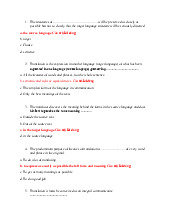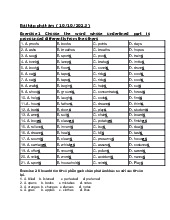


Preview text:
Giao thoa văn hóa
Câu 1: Cross-cultural communication is communication (verbal and nonverbal)
between people from different cultures, communication that is influenced by
cultural values, attitudes and behavior; the influence of culture on people’s
reaction and responses to each other
Câu 2: I think the most adequate definition is Culture can be defined as all the
ways of life including arts, beliefs and institutions of a population that are
passed down from generation to generation. Culture has been called "the way of
life for an entire society." As such, it includes codes of manners, dress, language,
religion, rituals, art.Because our culture measures our quality of life, our vitality
and the health of our society. Through our culture we develop a sense of
belonging, personal and cognitive growth and the ability to empathize and relate
to each other. Direct benefits of a strongand vibrant culture include health and
wellness, self esteem, skills development, socialcapital and economic return.
Culture refers to the customs and social behavior of the people in a given
community and it highlights the manifestations of intellectual achievements
belonging to the body of the people comprising that community collectively. As
Mahatma Gandhi once said, " A nation's culture resides in the hearts and in the
soul of its people". Therefore, we should do our best to preserve and respectour
culture, but at the same time, we must continue to modify, change , and improve
itbecause our self identity is reflected through the way our culture looks to the others.
Câu 3: Differences in high-context and low-context communication styles
across cultures influence the way people perceive information. High-context culture Low-context culture Concept Most of the information is
The mass of information is vested in
either in the physical context the explicit code [message]. or initialized in the person. Association ◆ Relationships are stable,
◆ Relationships are short-lived. buildup slowly, and are based on mutual trust. ◆ Clear boundaries
◆ Ambiguous boundaries allow distinguish between people
many people to be in a certain social inside and outside a social circle. group or circle.
◆ Execution of a task depends ◆ Tasks are carried out by following on the relationships between predetermined protocols and the people and the attention
procedures, and attention is paid to paid to the group process. the end goal.
◆ Identity of the individual is ◆ Individual’s identity is established established according to the
by himself/herself and his/her groups he/she belongs to achievements.
(family,culture, work, friends, etc.).
◆ The social structure is not
◆ Specific hierarchy is seen in centralized, and the authority is
social structure and authority.
distributed on various levels. Each The responsible person at the
level is in turn responsible for
toplooks out for the benefit of something the group Interaction ◆ Extensive use of gestural
◆ Conversation involves extensive elements in carrying out a
use of verbal elementsinstead of
conversation (e.g., voice tone, nonverbal ones. facial expressions, eye movement, body language, etc.). ◆ Information is conveyed
◆ Information is conveyed explicitly implicitly, and is heavily
in a precise and easy to understand dependent on context rather
form. It depends on the actual words thanactual words. rather than the context.
◆ Communication is indirect, ◆ Communication is direct, lengthy, and around the succinct, and to the point. point.◆ Communication is
◆ Communication is regarded as a
considered as an art, and as a
means to exchange information,
means to establish and nurture ideas, and facts. relationships. ◆ Any disagreement or ◆ Disagreement is not taken
conflict is taken personally. A personally, but is chalked up to differing opinion is seen as
adifference in opinion/outlook that being personally threatening,
does not affect the individuals
and hence conflict must either personal relationship. Instead, both
be avoided or resolved as soon individuals focus on formulatinga as possible rational solution. Territoriality ◆ There is no concept of
◆ Privacy is extremely important; personal space, instead it is
hence, every individual has his own viewed as a communal entity,
personal space which is rigidly where people stand close to
defined. As a result, people are eachother and share the same isolated from one another. area. ◆ Time is perceived as a
◆ Time is perceived as a commodity,
natural process that belongs to and hence can be spent or saved. The others and nature, not to
concept of personal time exists.
individuals, i.e. no concept of
◆ Societal change can be rapidly personal time.
induced, and any affected change ◆ Any sort of change in the yields immediate results.
society is slow to occur as the
◆ Time is scheduled for various
societal practices are rooted in tasks such that a particular task gets history and have a stable
done within a specific time frame in base.◆ No specific time
the most efficient way as possible schedule is observed, and
activities are carried out when it is suitable, aslong as the activity is completed Learning ◆ Deductive type of
◆ Inductive type of thinking. thinking.◆ Multiple sources ◆ Only singular source of
or information are utilized in
information is utilized to develop gaining knowledge. knowledge. ◆ Knowledge is gained from
◆ Gained knowledge is subject to situation-specific cues.
the individual’s perception. ◆ Learning is achieved by
◆ Learning is achieved by following
initialobservation followed by
directions and explanations of replication and practice. others. ◆ Learning and problem
◆ Learning and problem solvingare
solvingare seen as group tasks. considered individual tasks.
◆ Quality and accuracy of the ◆ Speed and efficiency of gaining gained knowledge is valued. knowledge is valued Example High context cultures are
High context cultures expect small more common in the eastern close-knit groups, where
nations than in western and in
professional and personal life is countries with low racial
interrelated. Such as: United States, diversity. Such as : China, Germany, Norway, Denmark, Korea, Japan, other Asian Switzerland, Sweden, Finland, countries
Canada, and other European nations




